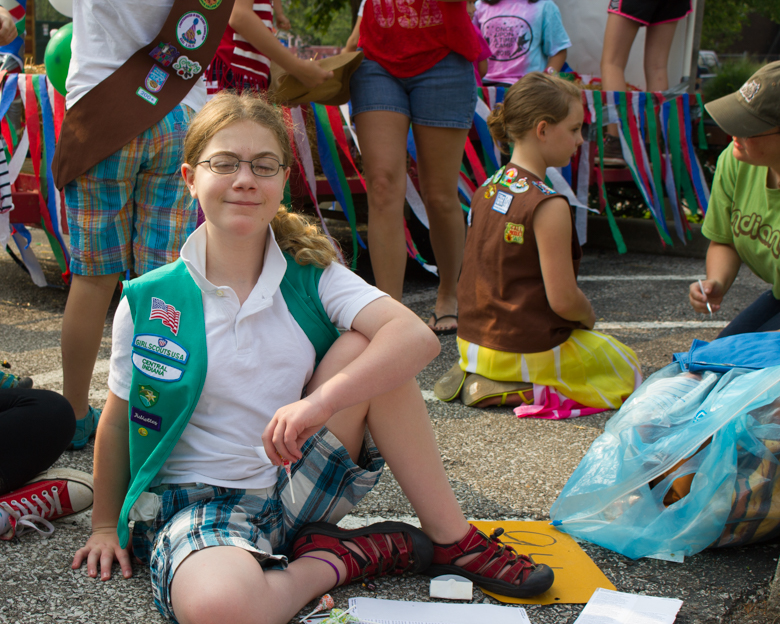As part of a long unit on World War 2, we're currently completing a short unit on World War 1--we'll study it in depth another time, but right now I'm primarily interested in having the children understand how World War 1 affected World War 2, so I'm emphasizing the timeline of events (using Story of the World
To that end, after reading about trench warfare in Eyewitness World War 1
I set up a LARP trench warfare activity for the kids. Here's what we used:
- inverted spray paint
. It paints on the ground, and we use this a TON for various yard games and projects.
- measuring tape
- two small shovels. I'd been kind of wanting child-sized, REAL shovels for a while, the better to put the children to work for me, so this was my excuse to buy them.
- water guns
- water balloons
- bandanas.
- bicycle helmets (optional). I'd wanted to add various items of clothing to imitate soldiers' uniforms, such as bicycle helmets and vests, but the day was too hot for that. Although heat exhaustion *would* be authentic...
First, the little kid and I measured out a battlefield. We needed space for two trenches, far enough apart to make hitting the other side with water balloons and water guns challenging but not impossible, with a No Man's Land in between. The little kid decided on a distance of about 13 feet, and it worked great.
The kids filled up a supply of water balloons, filled up a bucket to serve as a reservoir for water gun refilling, and dragged it all out to our war zone.
I wasn't sure how much effort the kids would want to put into digging their trenches, so I simply left them to it, asking them to tell me when they were both finished. This is what it looked like while they were working, before I sneaked off to have a snack and read for a bit:
This day was the only day this week that it didn't rain (and it's raining again today, sigh...), so the ground was quite soft, which helped the kids create some truly epic trenches for themselves:
Notice the piling up of the dirt to make a barrier in front of the trench? Good form!
When the kids were finished, they each ended up with a trench and barrier deep enough to crouch behind. Pretty perfect, I think:
When the kids had filled all the water balloons, they were left with an odd number, so it was decided that I would begin the war by playing the part of terrorist Gavrilo Princip and tossing a symbolic water balloon into the air; this was done, and war had begun!
Prior to the beginning of the war, there had been much debate about who wanted to be which country; the big kid wanted Germany, but the little wanted Austria. Then she wanted Russia. When you're playing war, why does everybody ALWAYS want to be the bad guys?
Finally, the little kid was persuaded to play France, so safely ensconced in their trenches, France and Germany commenced their bombardment:
 |
| See the water balloon? |
 |
| Germany goes over the top! |
 |
| Retreat! |
When someone needed to refill her water gun or rebuild her trench, she could shout, "Armistice!", and temporarily pause the war:
And then, back to war!
Of course, things got out of hand. First, France chased down Germany, knocked her down, and threw a bomb in her face. In retaliation, Germany kicked in France's trench and stole the rest of her bombs. France looked like this--
--and Germany looked like this:
Fortunately, France recovered (after I reminded her that FRANCE wins, not Germany), and all was again well:
This activity turned out WAY better than I'd hoped it would. The kids were really into it, they remembered enough from our World War 1 studies to naturally add some authenticity to their role-play, they got some great exercise and had a fabulous time, and I seriously doubt that they will ever forget the major contenders or major form of warfare of World War 1.
The kids asked to leave the trenches in place, which is fine, but I required them to pick up all water balloon shrapnel at the end of the game. Eventually, I'll have them fill their trenches back in, although if they wanted to use that space to make a couple of permanent forts...
...well, I wouldn't protest.
P.S. Want to follow along with my craft projects, books I'm reading, road trips to weird old cemeteries, looming mid-life crisis, and other various adventures on the daily? Find me on my Craft Knife Facebook page!
























































